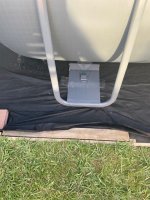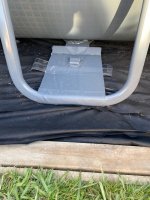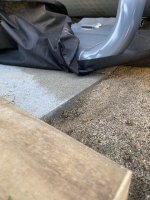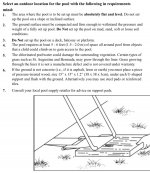Hi all
We are new owners of a rectangular above-ground Intex pool. We did all the research, watched copious amounts of Youtube videos and thought we had everything just right. We did the ground work to level the area, put sand on top for cushioning, got some thick pavers to go under each leg (which is sitting on clay), made sure these were level, we put the pool up and filled it.
However, today, not even a full day after the pool's been filled, we noticed that one of the pavers cracked in half. As we created a boxed in area for the pool, my husband put a block of wood inbetween the paver and the box, to support it so the paver doesn't move further from under the leg. The other half of the paver is poking up towards the vinyl sleave and we did wedge rubber in between to make sure that the paver does not rub the vinyl and risk breaking it. Other than that the level itself is amazingly still fine. In fact it's pretty much perfect level.
Now the question is - do we leave it like this and just monitor the situation to make sure it doesn't get worse, or do we drain the pool and replace the paver? I really don't want to have to drain it as this would be the second time we'd have to do it within the week (the first time we put up a pool that was used and had leaky problems).
Any ideas as to what else we could do would be appreciated.
Many thanks
We are new owners of a rectangular above-ground Intex pool. We did all the research, watched copious amounts of Youtube videos and thought we had everything just right. We did the ground work to level the area, put sand on top for cushioning, got some thick pavers to go under each leg (which is sitting on clay), made sure these were level, we put the pool up and filled it.
However, today, not even a full day after the pool's been filled, we noticed that one of the pavers cracked in half. As we created a boxed in area for the pool, my husband put a block of wood inbetween the paver and the box, to support it so the paver doesn't move further from under the leg. The other half of the paver is poking up towards the vinyl sleave and we did wedge rubber in between to make sure that the paver does not rub the vinyl and risk breaking it. Other than that the level itself is amazingly still fine. In fact it's pretty much perfect level.
Now the question is - do we leave it like this and just monitor the situation to make sure it doesn't get worse, or do we drain the pool and replace the paver? I really don't want to have to drain it as this would be the second time we'd have to do it within the week (the first time we put up a pool that was used and had leaky problems).
Any ideas as to what else we could do would be appreciated.
Many thanks





 Since the pool is currently level and seems to have stabilized (for now), I would leave it. Your actions to ensure the portion of the paver closest to the pool liner can't poke through, and the outer end blocked-in to prevent it from slipping outwards, may allow you to just monitor for a whie. But if that leg slips through the crack in the paver you'll have no choice but to fix it.
Since the pool is currently level and seems to have stabilized (for now), I would leave it. Your actions to ensure the portion of the paver closest to the pool liner can't poke through, and the outer end blocked-in to prevent it from slipping outwards, may allow you to just monitor for a whie. But if that leg slips through the crack in the paver you'll have no choice but to fix it.
